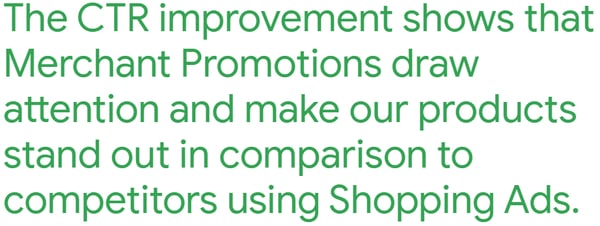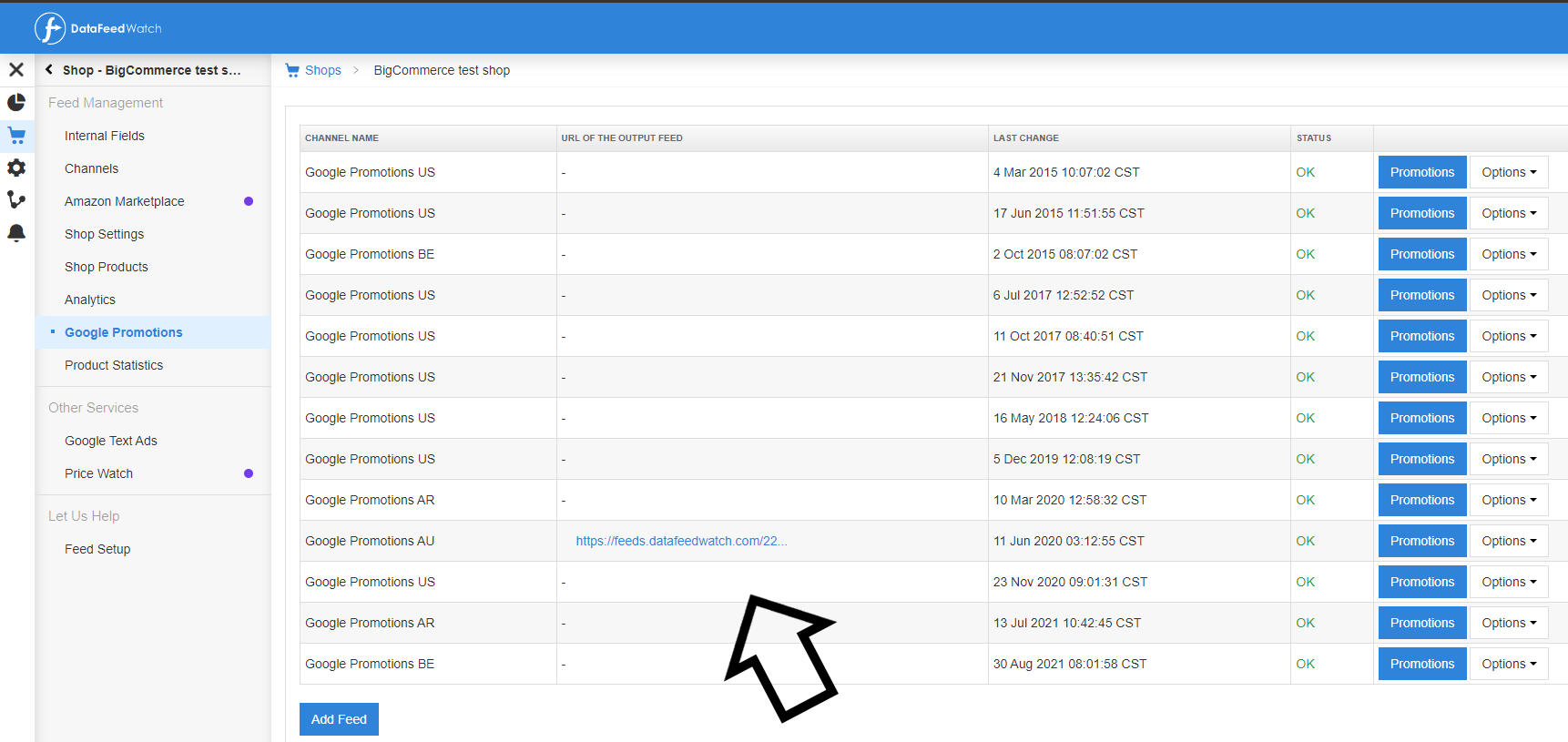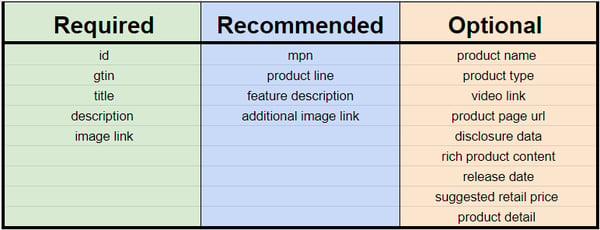Merchants use Google Shopping to promote their inventory, drive quality traffic to their online stores and increase overall sales. Along with the main Shopping feed you might already be familiar with, there are additional varieties of feeds you can use depending on your needs. We’ll take a look at them all.
Get your own copy of 6 Google Shopping Feed Types and How to Use Them
Meet the cast: Different Google Shopping Feed Types
Google has created various programs within Google Shopping to better assist merchants and to accommodate the types of products they sell.
In order to have products listed on Google Shopping, merchants have to submit product information via data feeds to Google Merchant Center.
In a lot of cases, the main Shopping feed could be all you need. But for some instances, like if you’re a product manufacturer or are selling your products locally, you can take advantage of one of these other feed types.
Let’s introduce you to the cast of feed types:
1. Google Merchant Center feed
AKA The Super Hero
This feed can do it all and make it look easy. Here to save the day, every day.
Purpose: This is the main feed that contains all the information about your product catalogue that will be sent out to Google Merchant Center.
File format: It must be uploaded as an .XML or .TXT file.
If you’re selling physical products, then this feed is for you.
It’s mandatory for your Google Shopping feed to contain these fields: id, title, description, link, image_link, price, condition, availability, brand, and gtin. If your products don’t have GTINs, you can use the identifier_exists attribute to signify that.
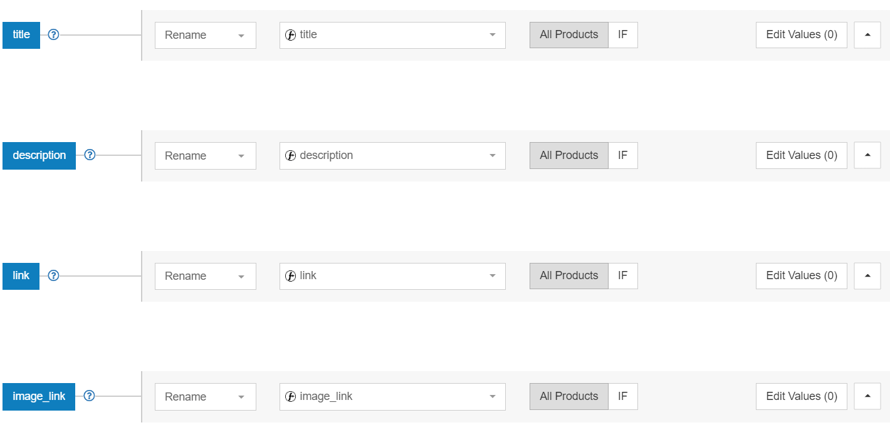
For apparel retailers the required fields also include: age_group, gender, color, size, material.
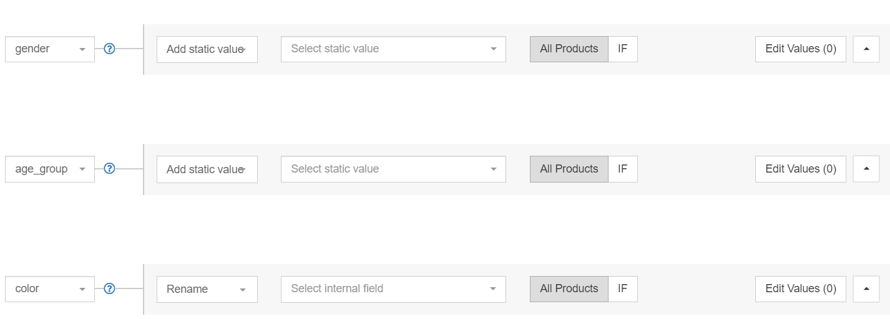
Other important optional attributes include product_type and google_product_category which further helps Google show your products to the right people at the right time.
Before you create the feed, make sure to check the comprehensive list of required and optional fields. It’s the safest way to make sure the feed is in line with all of Google’s requirements.
How to create and optimise your feed
If your products are already listed somewhere on the internet (like your own site or a shopping cart, for example) then you likely already have the base for your product feed. Even if you have all the information and data needed in one document, you should still take the time to optimize further. The easiest way is to use a feed optimization tool like DataFeedWatch.
Supplemental feeds
You can also use supplemental feeds together with this one. They will allow you to quickly make changes in bulk, add seasonal custom labels, and more. Like the name suggests, this is only an add-on to your main feed and only the products you want to make changes to should be included.
Keeping your feeds fresh
How often should you send feed updates to Google Merchant Center? The requirement is at least once a month, but we advise to have at least a daily update. This goes for most of the other feed types as well. If your feed changes a lot throughout any given day, then you should consider more frequent updates.
How DataFeedWatch can help
If you use a feed management solution like DataFeedWatch, it can really make it super easy to set up the primary Google Merchant feed. Thanks to the Google Shopping template that DataFeedWatch provides, you can make sure that you've created a perfectly optimised and error-free feed, and there's no risk of Google not approving any of your items. This tool will also serve you with automatic feed updates on a daily, weekly or even more frequent basis.
 Using DataFeedWatch, you can also enrich your product feed with additional attributes that you wouldn't have thought of, so you can stand out from your competitors and increase your sales.
Using DataFeedWatch, you can also enrich your product feed with additional attributes that you wouldn't have thought of, so you can stand out from your competitors and increase your sales.
With such a solution, you can easily replicate your Google setup to all other channels you want to sell on, for example Facebook, Fruugo etc.
2. Dynamic Remarketing Feed
AKA The Athlete
This feed is flexible, agile, and quick to adapt.
Purpose: Retargeting shoppers that visited a product page or abandoned a shopping cart.
Dynamic retargeting will allow you to display tailored ads to past visitors based on their activity from your website.
Feed format: You have to submit your regular feed to Google Merchant, in an .XML or .TXT format.
There are a few steps you need to take on order to use dynamic remarketing.
- Submit your data feed through Google Merchant Center
Note: It can take up to 3 business days for your feed to become validated. - Link your Google Merchant Center and Google Ads account together.
- Create a dynamic remarketing campaign.
Already have your main Shopping feed set up? You can simply use the same data to create your dynamic remarketing feed, or add additional attributes to your existing Shopping feed.
You can also add some additional fields to the document like display_ads_id, display_ads_title, and ads_label. Here’s the full list:
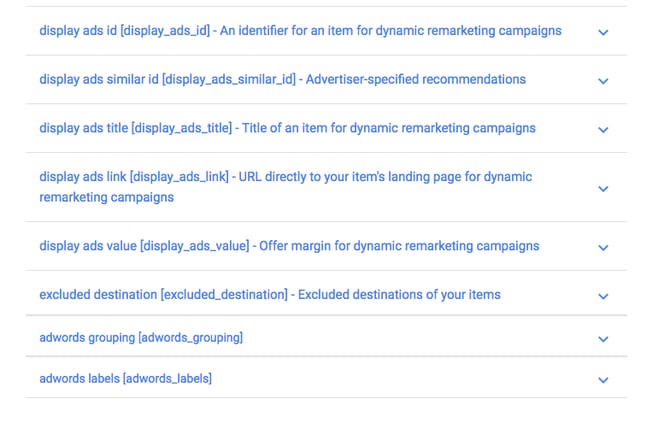
It’s important to note that, although a lot of the same data can be used between Shopping and dynamic remarketing feeds, they both have different policies. This is because laws around users’ data and privacy are very strict. These ‘personalized advertising’ policies ensure that you’re using that data responsibly.
How DataFeedWatch can help
With the DataFeedWatch feed management solution, you can create a separate dynamic remarketing feed based on the data in your regular Google Merchant feed. You can also simply add some extra attributes to your Google Merchant feed and use this single primary feed for multiple purposes.
The DataFeedWatch management tool can help you ensure that all the necessary attributes are included in your Google Manufacturer Center feed. In addition, you will know which additional attributes can help you achieve better results in Google Shopping campaigns.
3. Google Local Inventory Ads feed
AKA The Couch Potato
This feed doesn’t like to venture very far and is more comfortable keeping things close to home.
Purpose: Google’s Local Inventory Ads are designed to help brick-and-mortar stores direct foot traffic to their physical stores.
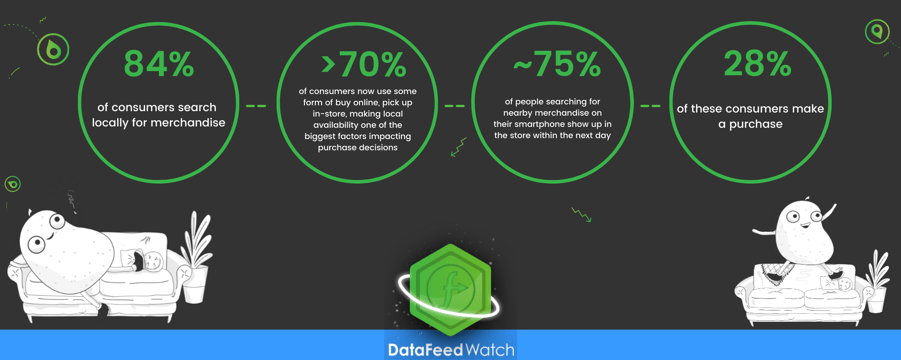
The importance of Local Inventory feeds
The importance of this feed has been highlighted through the emergence of the pandemic in 2020. At this time, shoppers are way more comfortable looking and paying for items online and then picking up their purchases safely in a physical store.
Aside from that, shoppers are always looking for the most convenient option. And for them it could be that browsing online and then picking up their items in the store (and having the items the same day) is better than waiting for them to be delivered. It’s also beneficial for shoppers low on time who are interested in buying a particular item. That way they don’t need to waste time visiting or calling multiple stores to find it.
84% of consumers search locally for merchandise, so it’s a good option for merchants and businesses looking to boost the sales and awareness of their store.
How to set up Local Inventory Ads
Here’s the steps you’ll need to take in order to set up your local feeds.
Requirements to use Local Inventory Ads
First, make sure that you meet all of Google’s requirements in the form of Do’s and Don’ts:
- Do allow all Shopping Ads policies
- Do have a store with a physical location that shoppers can actually visit, in the country you’re advertising in
- Don’t require any kind of membership in order to make purchases
- Don’t collect any personally identifying information from customers
And you must be located in one of the following countries:
- Australia
- Austria
- Brazil
- Canada
- Denmark
- France
- Germany
- Japan
- Netherlands
- Norway
- Sweden
- Switzerland
- the United Kingdom
- the United States
Setting up Local Inventory Ads step-by-step:
- In order to enable Local Inventory Ads, you’ll need to have 3 different accounts set up:
Google Ads account - This will be where you manage your ads.
A Merchant Center account - this is where you’ll store your products. You’ll already have this account if you’ve used Shopping ads.
Google My Business Locations - This is how you’ll be able to connect all the information about your physical locations. - Activate the Local Inventory Ads program. If you’re in a European country then you’ll also need to verify your ‘About’ page.
- Time to create your feeds! This includes a primary Shopping feed if you don’t already have one. We’ll go over more on how to create your local feed below.
- Once your local feed is ready, you’ll need to register and submit it.
- Then you’ll need to submit a request for your inventory to be verified.
- The last step is activating your local inventory ads for your Google Shopping campaigns.
How to create a Google Shopping local feed
First, let’s take a look at the required and optional attributes.

Required local feed attributes
- Store code
- Id
- Quantity
- Price
Optional local feed attributes
- Sale price
- Sale price effective date
- Availability
Once it’s all together, it will look something like this:
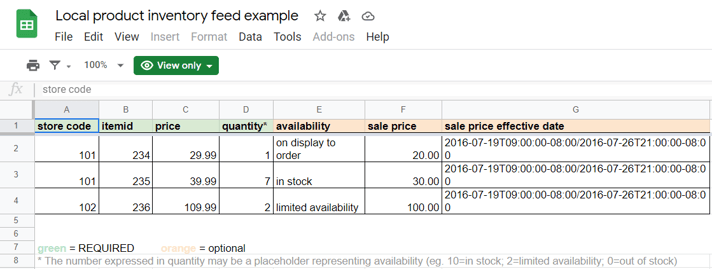
How often should you submit these feeds?
- Local products feed – at least once per week;
- Local product inventory feed – at least once a day.
Full vs. Incremental Local Inventory ads
Full Local Inventory Ad Feeds are updated daily and include your whole inventory.
If there are many changes being made to your inventory on a daily basis then it’s best to use an incremental Local Inventory feed. To make your feed incremental, log into Merchant Center and go to Product > Feeds > Settings and choose the option that says “Retain items no longer provided in the feed”.
Local feeds partnership program
There is a possibility for some merchants to have local inventory ads without creating an extra feed. To take advantage of the opportunities offered by Local Inventory Ads, merchants have to create 3 additional feeds, with the list of all the products they sell in stores.
- Business information feed - will list the information regarding all your business locations.
- Google Local Products Feed - this feed will include information about the products you sell only in-store or both online and in-store. Learn more here.
- Google Local Product Inventory Feed - will include stock information and price for each physical location. Learn more here.
Matching the four data feeds: Google Business Locations, Google Local Products Feed, Google Local Product Inventory Feed and Google Products Feed will be done automatically by Google via the ''item_id'' attribute.
Buy Online Pick up in Store (BOPIS)
When your customers with a BOPIS (buy online, pickup in store) preference are shopping, they’ll be able to tell right away that you’re the merchant for them.
In this case they would most likely choose Bed Bath & Beyond or Target over Macy’s.
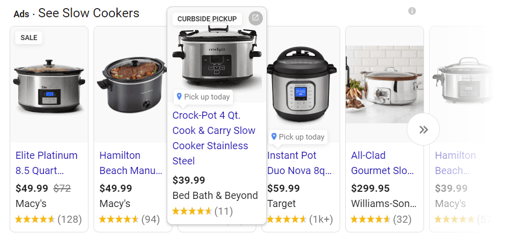
Selling online for the first time?
As we mentioned before, the start of the pandemic really brought out the desire for online shopping with consumers. And, with more and more things turning digital, it just makes sense that you’d want to go that route. Check out our article about moving your brick and mortar store online for some practical tactics.
It also probably means that you’ll be creating your first Google Shopping feed as well. We've also got you covered with 10 beginner Google Shopping optimization tips.
How DataFeedWatch can help
Using a third-party tool like DataFeedWatch can really make creating additional feeds like a local feed a breeze. It will also help as you continue to do business with automatic feed updates (weekly, daily, or more often). This is especially important when you have an inventory that’s always changing and if you’re selling online and in person.

Plus, If you decide you want to expand outside of Google Shopping you can copy the feed settings and use it as a base for other channels like Facebook.
FAQ
Do you need a separate local feed for each physical location?
Yes, you’ll need one feed for every store location that you have and want to sell from.
How do I know if Local Inventory Ads are right for me and my business?
4. Google Promotions Feed
AKA The Bargain Hunter
Here to showcase the latest and greatest deals on the SERP.
Purpose: Adding promotional text to product listing ads in Google Shopping.
File format: You can upload your feed via an XML, tab-delimited (.txt), or Google Spreadsheets file.
Merchants can use the Google Promotions Feed to boost the CTRs of their listing ads on Google Shopping. Currently the service is available in a limited number of countries: Australia, France, Germany, India, UK and US.
The program is going to be made available to other countries and you can check on their Merchant Promotions page to see if your country has been added to the list.
Why a Promotions feed?
As it stands, you’re only able to set up one promotion at a time. But, if you’d like to run multiple promotions, you can create a special feed to make it happen. Google even did a case study with Office Depot and found a 9.3% CTR lift in their German branch.
In order to use Promotions feed, merchants have to submit a Merchant Promotions Interest Form. Once your Google promotions application is approved, there will be an extra feed type to choose in Google Merchant Center.
The promotions feed has 6 required fields: promotion_id, product_applicability, offer_type, long_title, promotion_effective_dates and redemption_channel.
Optional attributes include: promotions_display_dates, description (not shown to users), generic_redemption_code, image_link, fine_print, and promotion_price.
Here’s a Promotions feed template:

And here is a sample of a mapped feed:
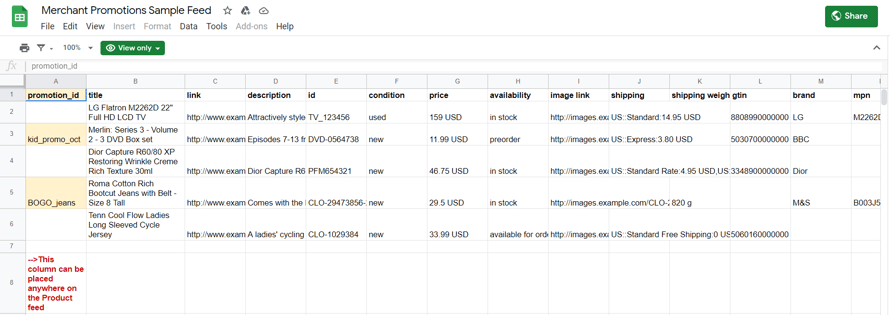
Before your feed and promotions can get approved, Google will need to review them and check to make sure that they comply with policies and requirements.
Promotion restrictions
Google has some pretty specific requirements for your promotions, and it makes sense. They want to make sure shoppers are being communicated with honestly.
- Free gifts must be an actual item rather than a free sample or subscription
- Discounts must be at least $5 or 5% off and can’t be vague (like cashback or a statement like “Up to x% off”)
- Can’t be overly restrictive (like a discount for first-time visitors only)
- Promotions can’t last longer than 6 months
You can find all the restrictions and what’s allowed here.
Product Filters
In addition to required attributes, there are product filters you can apply if your promotions aren’t for all your products.
These filters are activated when you set product_availability to specific products.
How DataFeedWatch can help
The DataFeedWatch tool can help you create a perfectly optimised Google Promotions feed. This solution will help you ensure that your feed contains all relevant attributes: Promotion_id, Product_applicability, Offer_type, Long_title, Promotion-effective_dates, Redemption_channel.
You can read more about adding Google Shopping promotions to the campaigns in this article.
Thanks to DataFeedWatch and the campaign feed you can create there, you can run multiple campaigns at once (without a dedicated Google Promotions feed, you can't create more than one campaign at a time).
Once you have created your Promotions feed in the DFW solution, it will be available under a URL, just like any other feed.
5. Product Ratings feed
AKA The Critic
This feed has opinions and isn’t afraid to let the world know!
Purpose: Adding Product Ratings & Google Merchant Reviews to the listings to build trust with potential buyers and increase sales.
Online shoppers rely heavily on reviews in Google Shopping, before deciding what to buy. You’ve probably been in a similar situation when making a decision between products. The one with the most 5 star ratings automatically seems more trustworthy.
While all these coffee makers have a significant amount of ratings, the one with 5 stars and over 5k ratings looks like a winner.
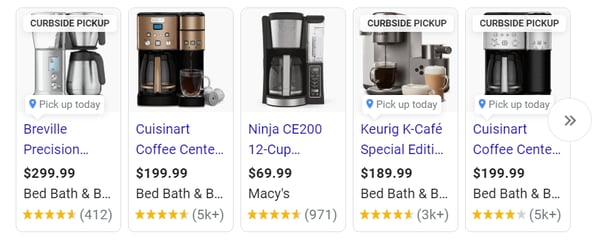
If we take a closer look at one of the reviews, we can see that shoppers are able to find answers to very specific questions about your product. Maybe a competitor has a better rating, but you have the specific feature someone is looking for.
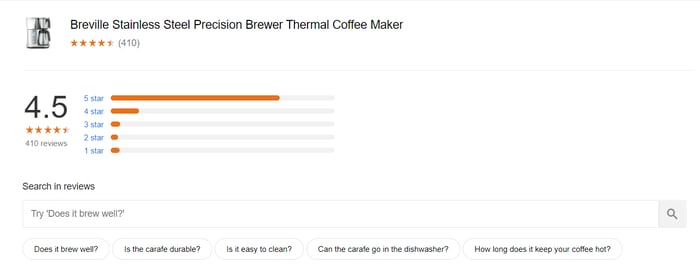
For ratings to show up on the product listings merchants have to send the product reviews to Google:
- by uploading feeds to the Merchant Center account;
- by submitting them via a third party review aggregator.
If the second option is preferred, Google will get the data directly from the aggregators and there will be no need for the merchant to submit the feed. However, if reviews are collected via the retailer's website, then creating a Google Product Rating Feed is necessary.
The updated feed needs to be submitted at least once per month. Otherwise, the document might contain potentially inaccurate data, which is not relevant for shoppers.
Failing to comply with this requirement can lead to your ineligibility to participate in the Product Ratings program.
One last thing: you must have at least 50 reviews for ratings to be displayed on your product listings in Google Shopping.
How DataFeedWatch can help
You can add your product reviews feed to your DataFeedWatch tool and get all your feeds in one place.
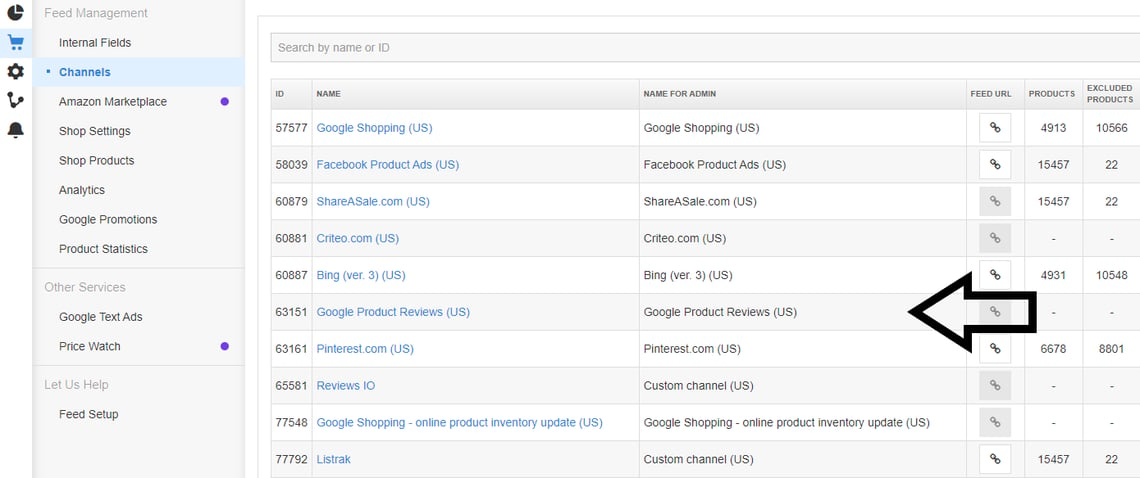
Then you can map it directly in the DataFeedWatch tool:
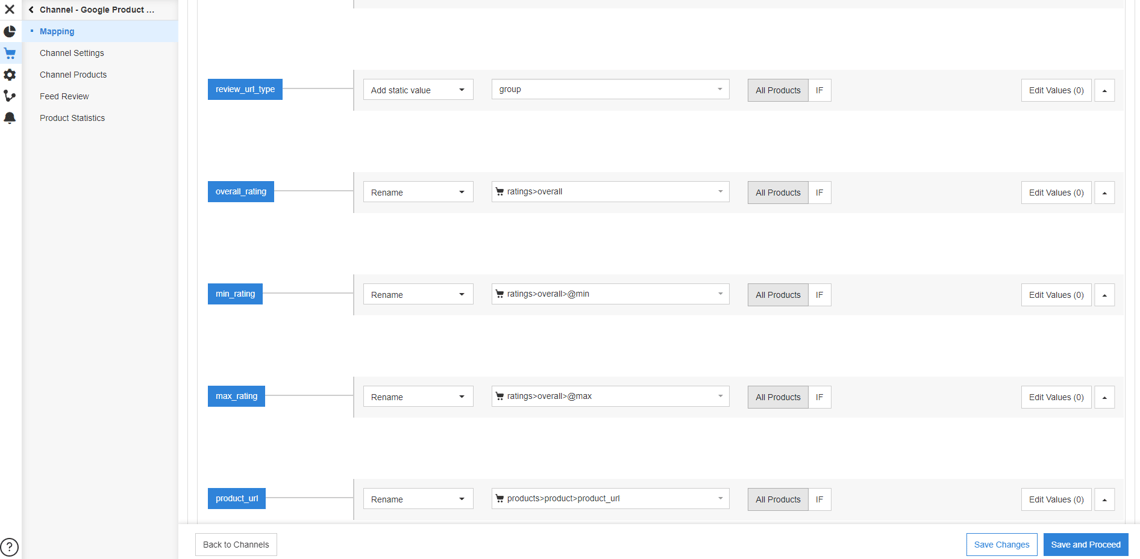
6. Google Manufacturer Center feed
AKA The Craftsman
This feed has no need to purchase items because they can just make it themselves.
Purpose: Gives more control to brand manufacturers and brand owners as to how their products are presented to shoppers on Google Shopping and other Google services.
If you’re the one actually creating or manufacturing physical products, then this feed is for you. To get started, you’ll also need a Google Manufacturer Center account.
With Google Manufacturer Center manufacturers can improve their presence on Google, by providing rich, accurate and standardized content to shoppers and retailers alike.
There are 6 required fields: id, gtin, title, description, image link and brand. However, you shouldn’t stop here. It’s recommended you fill in additional attributes, since it will allow shoppers to search and find your products more easily.
Including GTINs has benefits like keeping the information about your products consistent across resellers and the internet. You’ll have more control over what information is shared about your products.
It’s worth mentioning that you can upload test feeds to find and review potential errors. These feeds won’t create items that are eligible for Google Shopping results.
Finally, keep in mind that you need a separate feed for each country where you submit products and you can have up to a maximum of 20 feeds per country.
How DataFeedWatch can help
The DataFeedWatch solution can help you ensure that all the necessary attributes are included in your Google Manufacturer Center feed. In addition, you will know which additional attributes can help you achieve better results in Google Shopping campaigns.
When you create a feed with self-made products, it's easy to make mistakes. In a DatafeedWatch tool, you can review your test feeds and make sure there are no errors and that your items are approved by Google.

Conclusion
Google Shopping is an excellent channel for getting your products in front of a large audience, and a way you can attract more customers. For the most part, you’ll be working most with our Super Hero - the main Shopping feed.
But we hope this article will help you better understand what type of product information you have to submit to Google, depending on your eRetail objectives.
Next Recommended Read: Data Feed Optimization for Beginners


